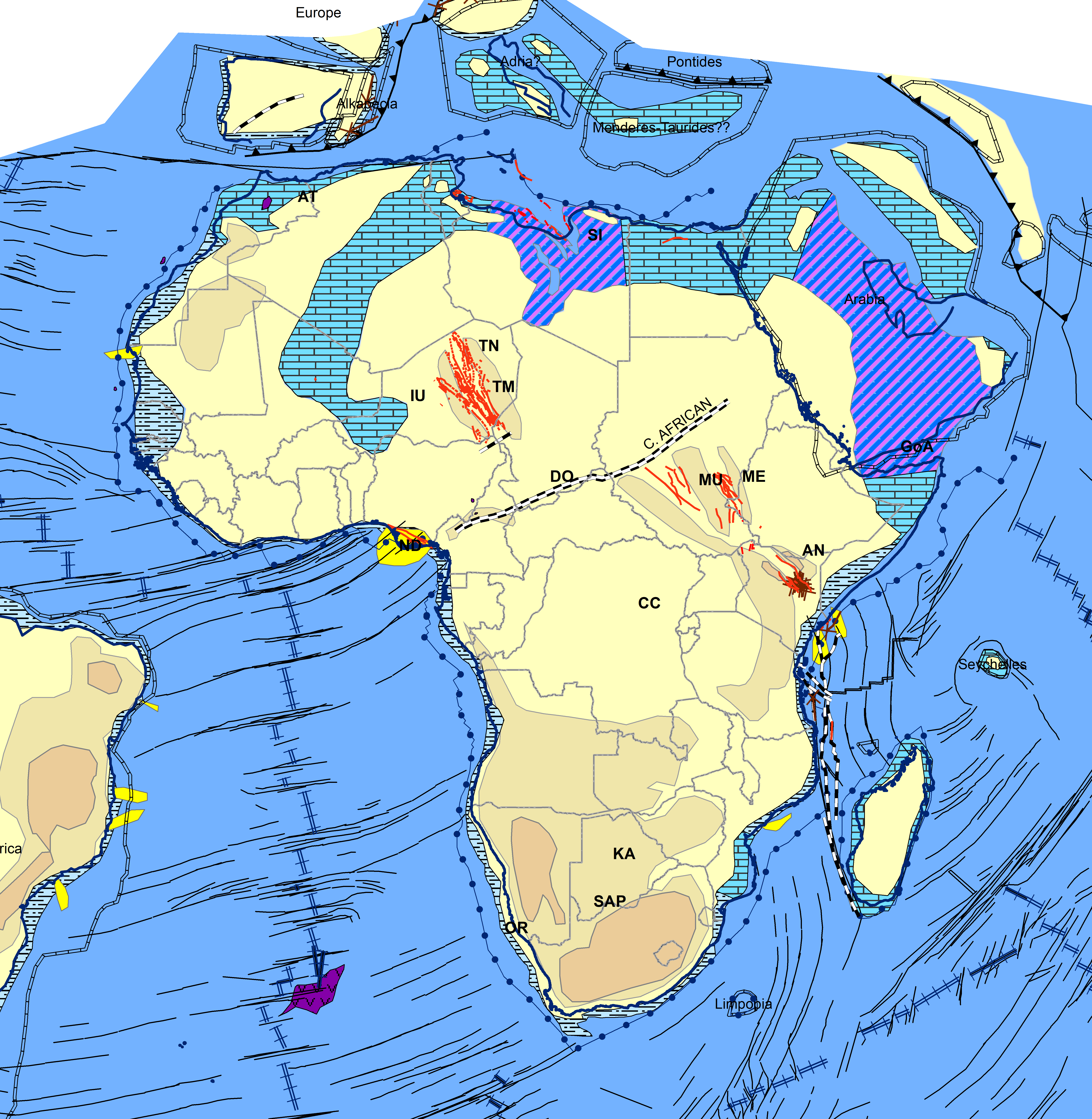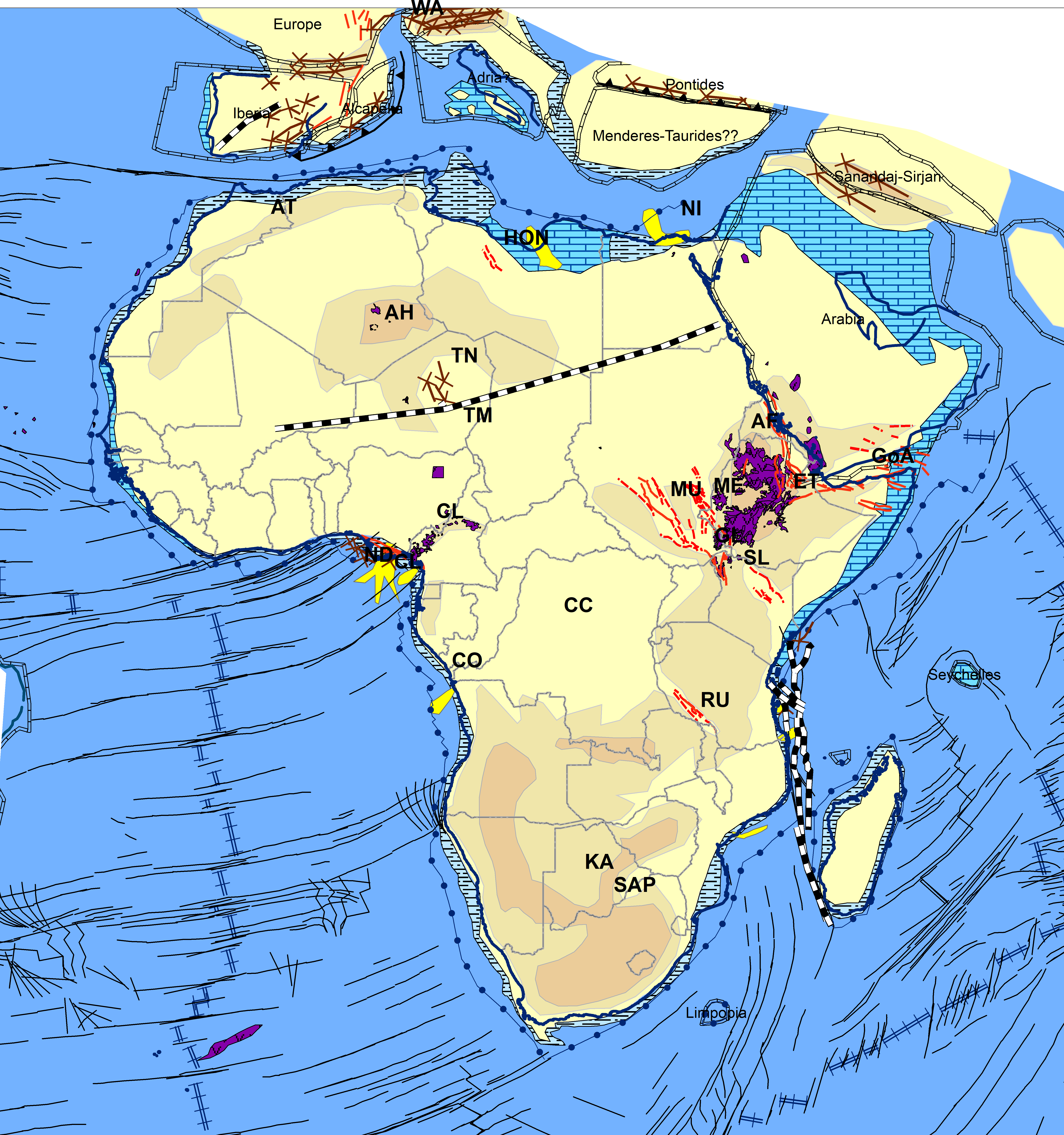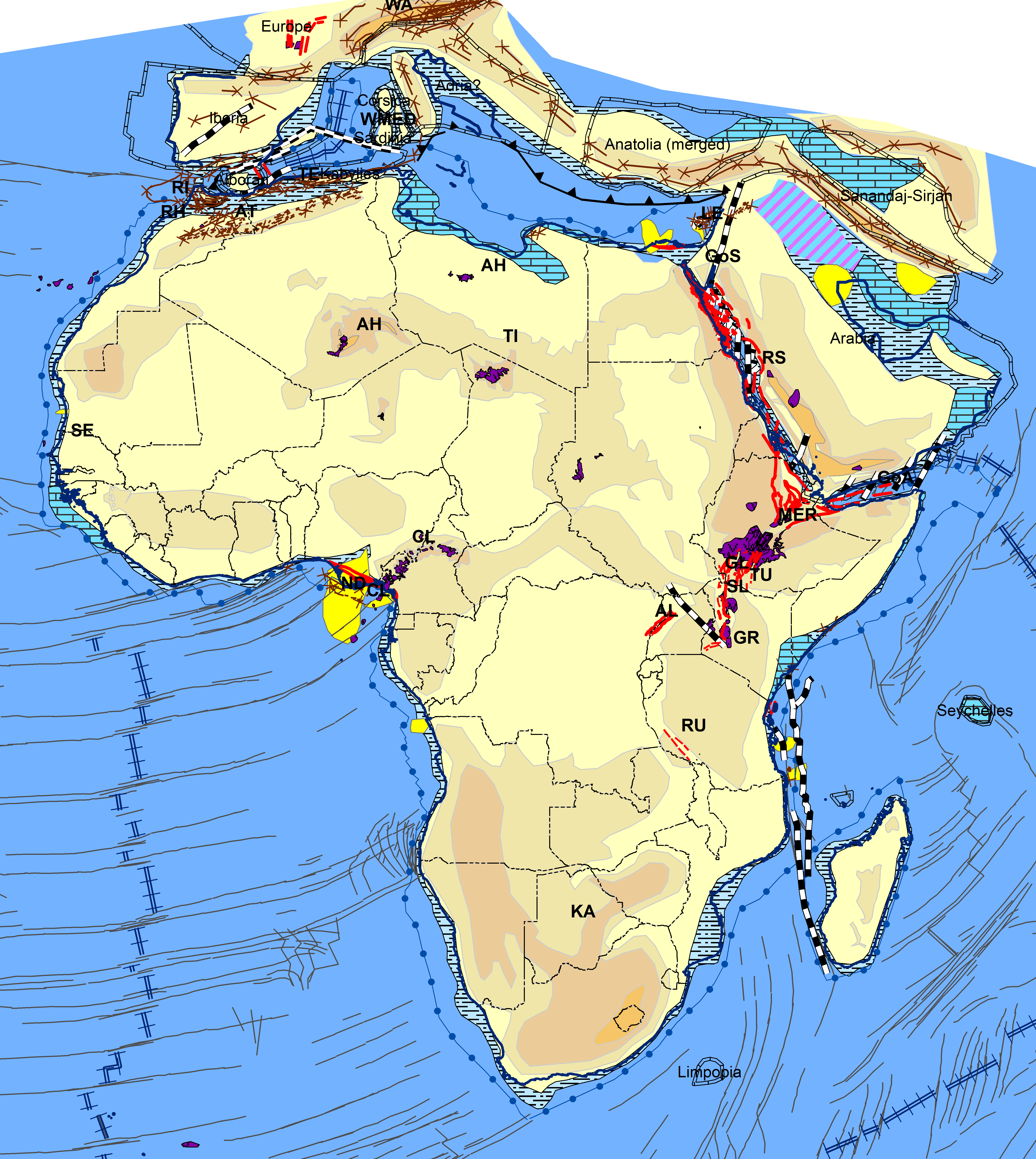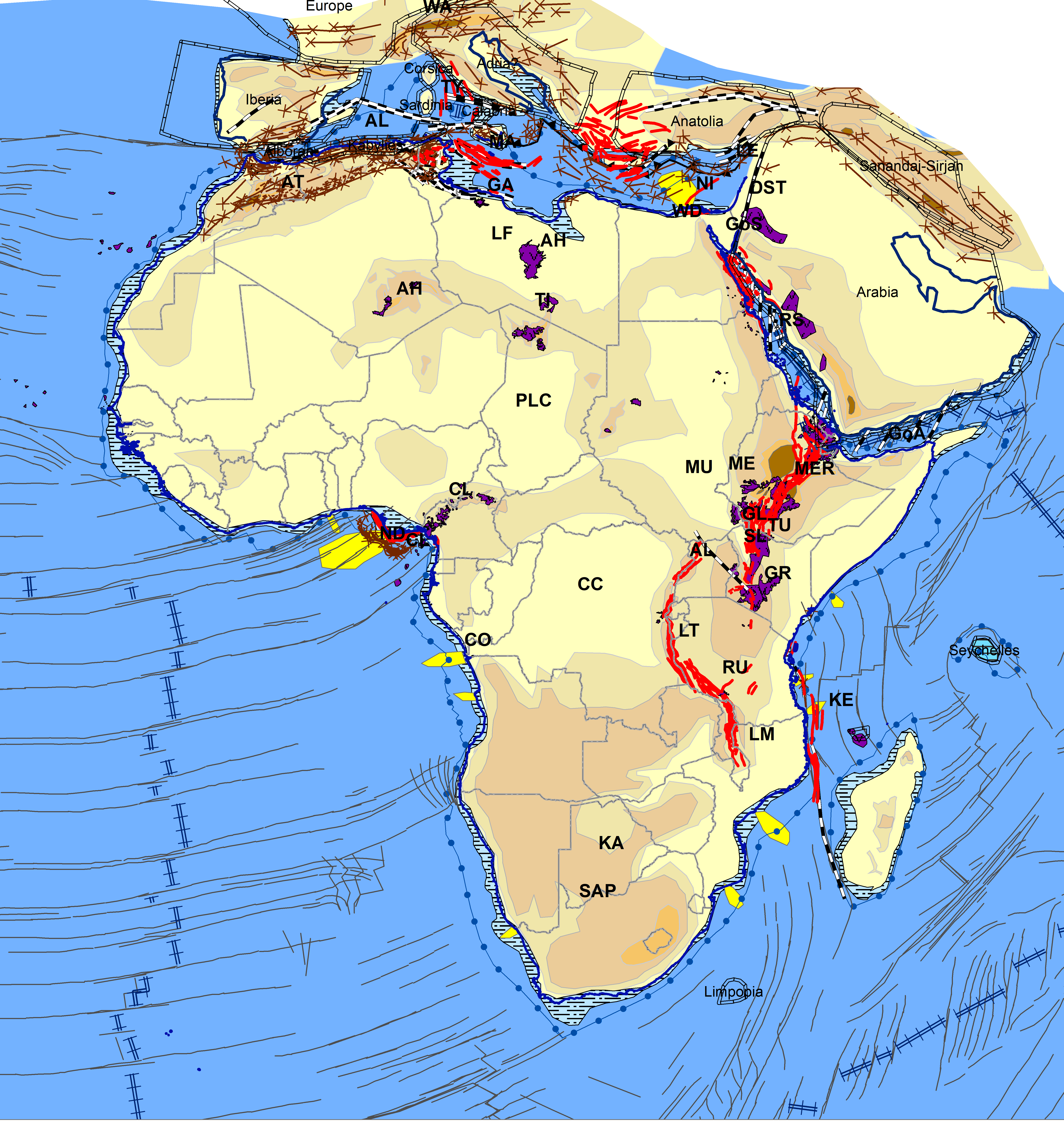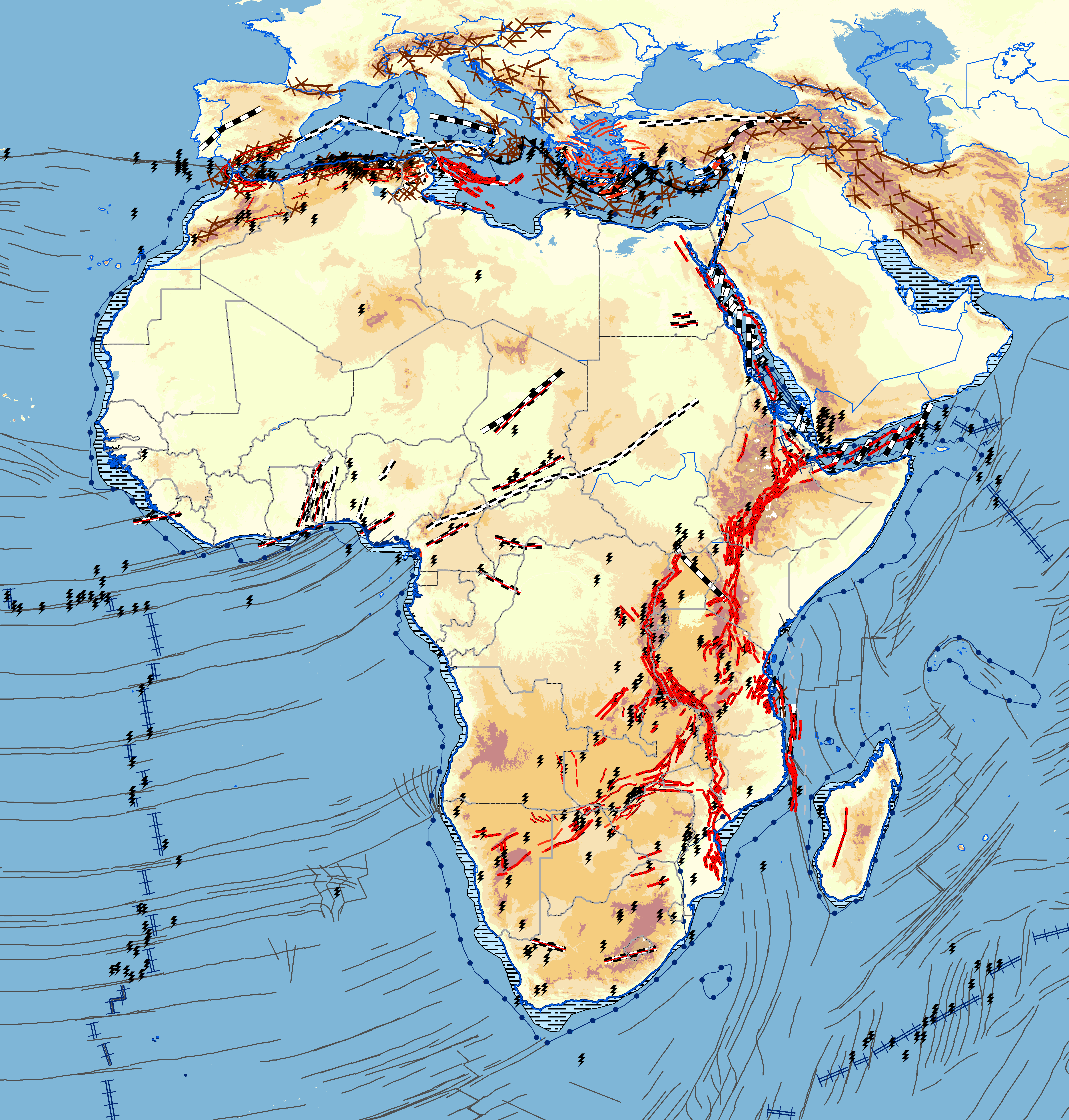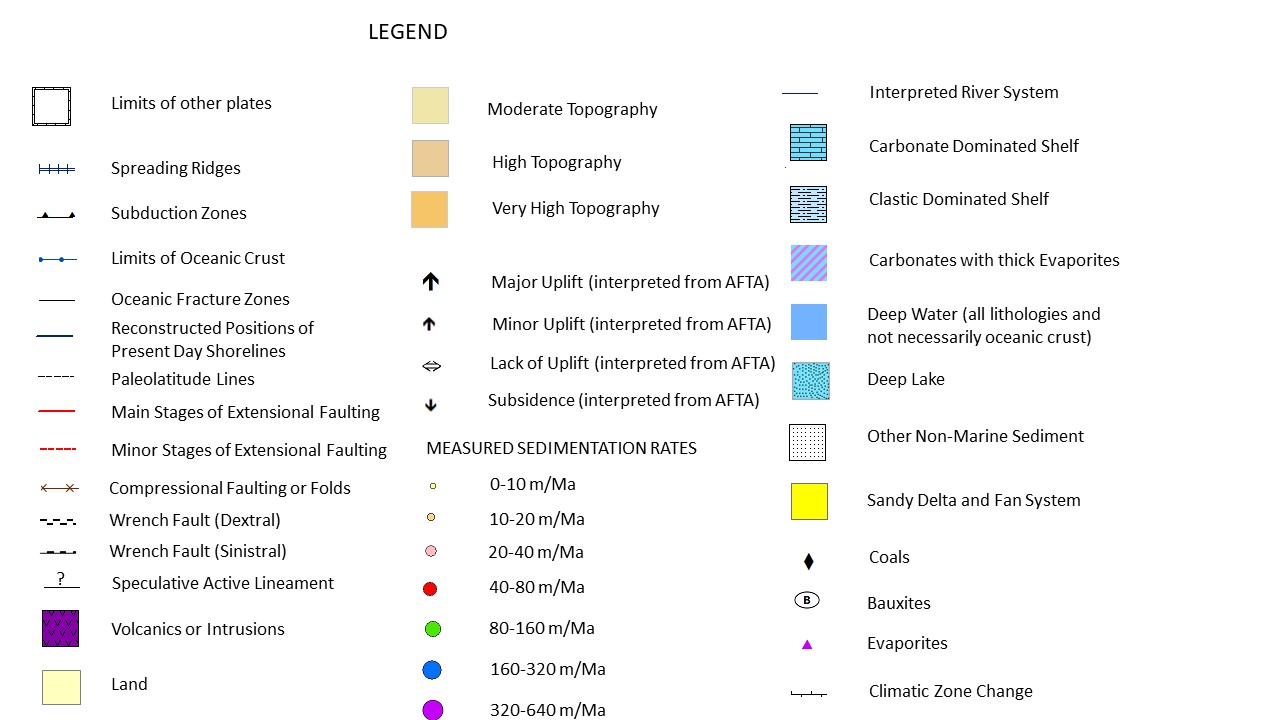This website is out of date and will shortly be deleted
Click here for new website and latest maps
CENOZOIC (TERTIARY) PALEOTECTONIC AND PALEOGEOGRAPHIC MAPS OF AFRICA
DRAFT 3 MARCH 2023
An ongoing project using the plate model of Colin Reeves (www.reeves.nl)
Comments welcomed
CLICK MAPS TO EXPAND
WATCH AT
watch at https://www.youtube.com/watch?v=YoNYyLGlxjA
Ypresian 50Ma
Paleocene to Mid Eocene times represent a relatively stable and quiescent period in terms of tectonics, erosion, sedimentation and climate. Africa is now closing on various European platelets but this does not seem to transmit to any tectonic activity on the African plate. Significant early post-rift subsidence characterises many of the Sirt (SI) rifts. The offshore Gulf of Sirt may still be rifting. The NW-SE trending Central African rifts (TM, TN, ME, MU) are again in a syn-rift phase, suggesting that the Central African lineament is still active, probably connected to Atlantic fracture systems. The Anza rift of Kenya (AN) also remains in a syn-rift phase, following a regional uplift of northern Kenya in the Latest Cretaceous to Paleocene.
.
Priabonian 35Ma
The previously quiescent tectonics of the Mid Eocene are broken by the first period of compression in the Atlas, the onset of volcanism in Ethiopia and perhaps the first weak extensional movements of the East African system. Climates however remains similar to that of the Ypresian. The Iberian plate collides with Europe, creating the ‘Pyrenean’ event (PY). The Iberian stresses appear to be transmitted somehow to the Atlas (AT), where the first period of inversion is seen, termed informally the ‘Atlassic event’. The degree of compression seems to have been greater in Morocco than in Tunisia. The first of a number of transpressional events are described along the Sabratah Fault (SA). Activity continues in the Central African Rift System, with continued extension of the Sudan rifts , contemporaneous with inversions in the Doba (DO) Basin. The Melut (ME) rift appears now to be more active than the Muglad (MU), with faulting now rotating from a previous NW-SE trend to NNW-SSE. Some small rifts in NW Kenya and the Broadly Rifted Zone (BRZ) of Ethiopia may start to gently subside at this time, which can be considered the first ‘EARS’ Rifts, though dating is uncertain.
Rupelian 30Ma
Compressional activity continues in Iberia and on the southern margin of the European plate but does not transmit into Africa. A backarc basin has now formed between Iberia and Alkapeca (at 32Ma). This will spread at circa 21Ma to create the Western Mediterranean Ocean. The only Sirt rift still active is the Hon Graben (HON). CARS extensional movements now seem to be confined to the Sudanese rifts. Rifting trends here are moving towards a more N-S trend, with the Melut Basin (ME) more active than the Muglad (MU) Basin. It is speculated that an E-W transform trend across Central Africa may have been active at this time, and that this forms the sharp boundary in Niger between the Tenere (TN) rift, which is highly inverted and the dormant Termit (TM) Basin. The South Lokichar (SL) Basin forms the first clearly evidenced rift of the East African Rift System, being thought to be the earliest rift within a first cycle of rifting confined to Kenya and southern Ethiopia. A mild rifting and filling episode also occurs in the multi-phase Rukwa (RU) Basin. From now onwards, an ‘unzipping’ trend of rifting is observed from the Gulf of Aden (GoA) to the Afar and subsequent to this period, north through what is now the Red Sea.
Langhian 15Ma
The Alkapeca set of plates detach from the Iberian Plate around 21Ma. Over a period of only around 3Ma, this new ocean spreads, with the Kabylies then colliding with Africa to create the Tellian (TE) structural event and nappe, while the Alboran Plate is squeezed westwards between Iberia and Africa, creating the Rif (RI) mountain chain and a large olistostrome in the Rharb Basin (RH). Subduction of the Eastern Mediterranean commenced at around 20Ma, following the accretion of Turkish microplates . An associated phase of folding and transform activity occurs in the Levantine Basin (LE) of Israel. Oceanic crust is now being established in the Gulf of Aden. The unzipping trend of rifting in the Red Sea has advanced northwards substantially, with a peak of activity around 20Ma. At 14Ma, the Dead Sea Transform is created, marking the end of syn-rift conditions in the Gulf of Suez (GoS). This time marks the end of the first phase of EARS rifting, which are confined to southern Ethiopia and northern Kenya, and the start of a second more extensive phase. Rifting in the Lokichar (SL)area jumps eastwards to Lake Turkana (TU). In addition to a spread southwards into the Gregory (GR) area of Kenya, the Aswa transform is created and rifting commences in the northernmost rifts of the Western Branch. The first rift fill of the Albertine (AL) Rift of Uganda was deposited at around 17Ma.
Zanclean 5Ma
Spreading commences in the southern part of the Red Sea (RS), though the northern part is thought to remain in a magma-poor hyperextended state. The initiation of further compressional tectonics in the Maghreb and thrusting in the offshore may indicate the creation of an accretionary prism along the southern edge of the Algerian (AL) ocean. A new northern boundary to the African plate has been created through the island of Sicily as the Tyrrhenian Sea (TY) opens and Calibria moves eastwards, splays creating a series of transtensional rifts around Malta (MA). Folding, often associated with wrench movements, also affects the Nile Delta. EARS rifting, particularly of the Western Branch, has now propagated considerably southwards. All rift basins between the Albertine Basin (AL) and Lake Malawi (LM) are now active, the latter forming at ca. 7Ma. A northwards propagation is interpreted in Ethiopia, now forming a continuous rift system . An offshore branch was also created in the Late Miocene, typified by the Kerimbas (KE) Basin offshore Mozambique. The offshore rifts do not seem to be connected by any lineaments to those in the onshore and show many contrasts with these (e.g. no high rift shoulders), so their tectonic context is uncertain .
Holocene/Present Day 0Ma
Evolution of the African plate continues, with collision with southern Turkey approaching as the final sections of the eastern Mediterranean subduct and a new subduction zone probably now being established below northern Algeria, evidence by earthquake epicentre depths and geothermal anomalies. The EARS is still expanding, with a new southwestern branch now established through Kariba (KA) to the Etosha (ET) and other through Lakes Mweru (LMW) and Upemba (LU) . Some authors now believe the ‘Somali Plate’ and the ‘San’ Plate, (containing South Africa), are in the process of rifting off the African Plate. Most surrounding oceans are spreading in parallel with the Africa plate, which would therefore be expected to be under compression : this is clearly not the case, indicating that there are other active forces below the plate itself. Some regions are still actively uplifting, e.g. the margins of the Kwanza (KW) Basin.
Active faults on this map are mapped from earthquakes. The main source used is Meghraoui et al, 2016.The map shows active volcanoes as purple triangles, those with mild activity in pink and recently extinct ones in orange.
